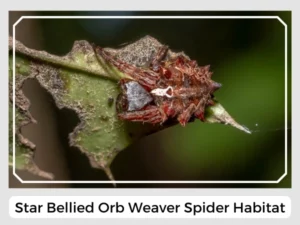The Starbellied orb-weaver is a special spider from the Araneidae family. You can often see it in places like Mexico and Canada, especially between late spring and early fall. Ready to explore some amazing facts about this spider? Let’s dive in!
Their eggs are small and round, enclosed safely in a sac, emerging in summer.
The spiderlings stay together for a while after hatching, eventually, they disperse to be on their own.
Like other orb weavers, these spiders too build wheel-shaped webs, spanning about 6 – 10 inches (15.24 – 25.4 cm).
Yes, Starbellied Orb-weaver Spiders do have venom. They use it mainly to catch and eat their prey.
They can bite, but they usually keep to themselves. If they feel in danger, they might defend themselves, but they’re mostly peaceful.
The Starbellied orb-weaver plays a pivotal ecological role. By feeding on a variety of insects such as beetles, moths, flies, and wasps, these spiders help control pest populations in meadows and grasslands, which is their preferred habitat. Their presence supports a healthy ecosystem, reducing the need for chemical pest control and promoting biodiversity.
Natural Predators: Despite their venomous bite, these spiders are not apex predators. They fall prey to birds, larger insects, and even other spiders. This vulnerability plays a significant part in the natural food web, as it keeps their population in balance.
Prey-Predator Dynamics: Starbellied orb-weavers have a classic predator-prey relationship with the insects they consume. Their venom paralyzes the prey, facilitating an easier meal and demonstrating a fine-tuned ecological balance where they serve as both predator and prey.
Relationship with Humans: The interaction between humans and Starbellied orb-weavers is minimal and generally harmless. They are not aggressive towards humans and bites are quite rare, occurring typically only in self-defense. Their role as natural pest controllers often makes them a welcome presence in gardens and farms.
| Other Names | Star-bellied orb-weaver, starbellied spider |
| Distribution | Southeastern Canada till Mexico |
| Habitat | Meadows and grasslands |
| Diet | Beetles, moths, flies, and wasps |
| Lifespan | Approximately 12 months |

In summary, the Starbellied orb-weaver’s role extends far beyond its striking appearance.
The Starbellied orb-weaver is a special spider from the Araneidae family. You can often see it in places like Mexico and Canada, especially between late spring and early fall. Ready to explore some amazing facts about this spider? Let’s dive in!
Their eggs are small and round, enclosed safely in a sac, emerging in summer.
The spiderlings stay together for a while after hatching, eventually, they disperse to be on their own.
Like other orb weavers, these spiders too build wheel-shaped webs, spanning about 6 – 10 inches (15.24 – 25.4 cm).
Yes, Starbellied Orb-weaver Spiders do have venom. They use it mainly to catch and eat their prey.
They can bite, but they usually keep to themselves. If they feel in danger, they might defend themselves, but they’re mostly peaceful.
The Starbellied orb-weaver plays a pivotal ecological role. By feeding on a variety of insects such as beetles, moths, flies, and wasps, these spiders help control pest populations in meadows and grasslands, which is their preferred habitat. Their presence supports a healthy ecosystem, reducing the need for chemical pest control and promoting biodiversity.
Natural Predators: Despite their venomous bite, these spiders are not apex predators. They fall prey to birds, larger insects, and even other spiders. This vulnerability plays a significant part in the natural food web, as it keeps their population in balance.
Prey-Predator Dynamics: Starbellied orb-weavers have a classic predator-prey relationship with the insects they consume. Their venom paralyzes the prey, facilitating an easier meal and demonstrating a fine-tuned ecological balance where they serve as both predator and prey.
Relationship with Humans: The interaction between humans and Starbellied orb-weavers is minimal and generally harmless. They are not aggressive towards humans and bites are quite rare, occurring typically only in self-defense. Their role as natural pest controllers often makes them a welcome presence in gardens and farms.
| Other Names | Star-bellied orb-weaver, starbellied spider |
| Distribution | Southeastern Canada till Mexico |
| Habitat | Meadows and grasslands |
| Diet | Beetles, moths, flies, and wasps |
| Lifespan | Approximately 12 months |

In summary, the Starbellied orb-weaver’s role extends far beyond its striking appearance.